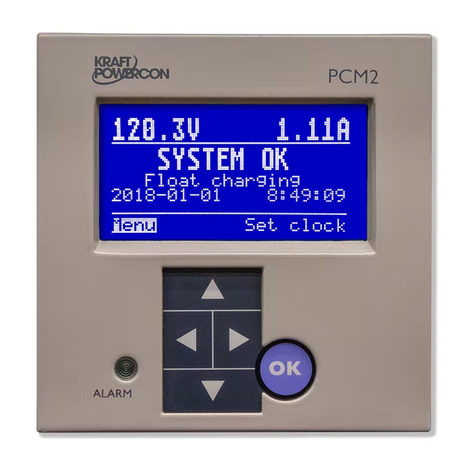
3
KraftPowercon Sweden AB, Hjalmar Petris väg 49, S-352 46 Växjö, Sweden, Tel: +46 470-705200, Fax: +46 470-705201,
www.kraftpowercon.com
CONTENTS
1 PRESENTATION..................................................................................................6
2 SAFETY INSTRUCTIONS ..................................................................................7
3 TECHNICAL DATA............................................................................................8
3.1 ASSORTMENT ...............................................................................................................................................8
3.2 Electrical data..................................................................................................................................................8
3.2.1 Electrical input data..................................................................................................................................8
3.2.2 Electrical output data ...............................................................................................................................8
3.3 ENVIRONMENTAL DATA ........................................................................................................................9
3.4 MECHANICAL DATA.................................................................................................................................9
3.5 CONFORMITY WITH STANDARDS .......................................................................................................9
4 FUNCTIONAL DESCRIPTION.......................................................................10
4.1 GENERAL......................................................................................................................................................10
4.2 RECTIFIER MODULES...............................................................................................................................10
4.2.1 General ......................................................................................................................................................10
4.2.2 Maneuvering and indications...............................................................................................................10
4.2.3 Voltage control.........................................................................................................................................10
4.2.4 Current control ........................................................................................................................................11
4.2.5 Temperature control...............................................................................................................................11
4.2.6 Output power control ............................................................................................................................11
4.2.7 Fan speed control....................................................................................................................................11
4.2.8 Loadsharing..............................................................................................................................................11
4.2.9 Overvoltage DC (HVSD).......................................................................................................................11
4.2.10 Over-/Undervoltage AC ........................................................................................................................12
4.2.11 External blocking.....................................................................................................................................12
4.2.12 Hot swap...................................................................................................................................................12
4.3 FUNCTIONS OF COMPLETE CHARGING RECTIFIER....................................................................12
4.3.1 General ......................................................................................................................................................12
4.3.2 Float charging ..........................................................................................................................................13
4.3.3 Equalizing charging................................................................................................................................13
4.3.4 Battery circuit test ...................................................................................................................................13
5 OPERATION .......................................................................................................14
5.1 GENERAL......................................................................................................................................................14
5.2 RECTIFIER MODULES...............................................................................................................................14
5.2.1 General ......................................................................................................................................................14
5.2.2 Manoeuvre................................................................................................................................................14
5.2.2.1 ON .........................................................................................................................................................14
5.2.2.2 STBY (standby) ...................................................................................................................................14
5.2.3 Indications ................................................................................................................................................14
5.2.3.1 AC OK ..................................................................................................................................................15
5.2.3.2 DC OK ..................................................................................................................................................15
5.2.3.3 ALARM ................................................................................................................................................15
5.2.3.4 CURRENT............................................................................................................................................15
5.2.3.5 <Indication table .................................................................................................................................16
5.3 MONITORING UNIT PCM2.....................................................................................................................16




























